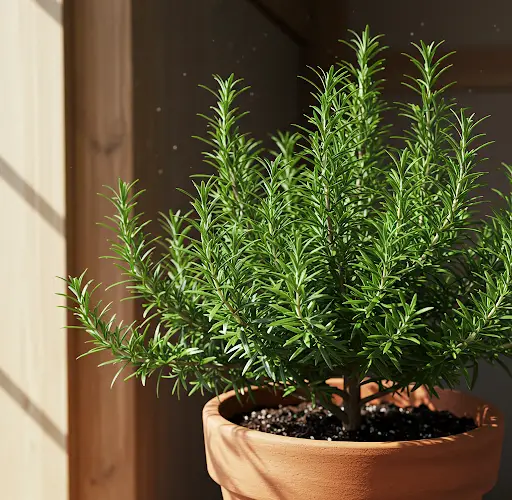Rosemary (Rosmarinus officinalis) is a versatile and aromatic evergreen plant that thrives in warm, Mediterranean climates. With its distinctive fragrance, medicinal properties, and culinary uses, rosemary is a valuable addition to any garden, terrace, or even indoor space. Its woody branches can grow up to 2 meters in height, with narrow, oblong leaves measuring 2-3 cm in length. The plant produces small white or light blue flowers that bloom primarily in spring and mid-autumn. Its fruit consists of small brown nuts enclosed in pods.
One of the reasons rosemary is so beloved is its resilience. It tolerates drought and high temperatures remarkably well, making it an ideal plant for regions with long, dry summers. It requires little maintenance and, once established, can thrive for years. In addition to its ornamental value, rosemary is prized for its medicinal properties and its many uses in cooking and home remedies. In this article, we will explore how to propagate rosemary easily, as well as its care requirements and various applications.
Propagating Rosemary
There are two main ways to propagate rosemary: by seed and by cuttings. While growing rosemary from seeds is possible, it is a slow and often unpredictable process. The simplest and most effective method is propagation through cuttings, which ensures faster growth and better success rates.
Step 1: Selecting and Preparing Cuttings
The best time to take rosemary cuttings is in spring when the plant is actively growing. Cuttings should be about 10 cm long, taken from healthy, non-flowering stems. Remove the leaves from the lower third of each cutting to expose the nodes where roots will develop.
Step 2: Using Rooting Hormones
To encourage root formation, dip the cut end of each cutting in water and then in a rooting hormone powder, which is rich in phosphorus. This helps stimulate root growth. If you prefer a natural alternative, you can use willow water—an organic rooting stimulant made by soaking willow cuttings in water overnight.
Step 3: Planting the Cuttings
Prepare a well-draining potting mix, such as a combination of soil and sand. Insert the cuttings about 3-4 cm deep into the soil, ensuring they are firmly in place. If you are propagating multiple cuttings, a Styrofoam container can be a convenient way to keep them organized. Otherwise, they can be planted directly into small pots or their final growing location.
Step 4: Providing the Right Conditions
Rosemary thrives in warm, sunny locations with good air circulation. Place the cuttings in a bright area with indirect sunlight. Keep the soil consistently moist but not waterlogged. It is beneficial to provide some shade to prevent excessive drying, especially in hot climates.
Step 5: Transplanting Rooted Cuttings
After about two months, the cuttings should have developed strong roots. At this stage, they can be transplanted into larger pots or directly into the garden. Ensure each plant has enough space to grow, as rosemary spreads over time.
Caring for Rosemary
Rosemary is a hardy plant, but to keep it thriving, consider the following care tips:
- Sunlight: Rosemary requires at least 6-8 hours of sunlight daily. It can be grown indoors if placed near a sunny window.
- Soil: Well-draining, slightly alkaline, and calcareous soil is ideal.
- Watering: While rosemary is drought-tolerant, it benefits from occasional deep watering, especially during prolonged dry periods.
- Pruning: Regular pruning encourages bushy growth and prevents the plant from becoming woody.
- Protection from Cold: In regions with harsh winters, rosemary should be protected from frost or grown in pots that can be brought indoors.
Uses of Rosemary
Rosemary is highly valued for its diverse applications in cooking, home remedies, and even skincare.
Culinary Uses
The leaves of rosemary have a strong, pine-like aroma that enhances various dishes. It pairs well with meats, fish, potatoes, and roasted vegetables. Fresh or dried leaves can be used, and rosemary sprigs can even be added to barbecue coals for extra flavor.
Medicinal Benefits
Rosemary has numerous health benefits, including:
- Digestive Aid: It helps improve digestion and reduce bloating.
- Memory Enhancement: Studies suggest that the aroma of rosemary can improve cognitive function and memory.
- Circulation Booster: A bath infused with rosemary leaves stimulates blood flow.
- Pain Relief: Used in massage oils, rosemary helps relieve muscle and joint pain.
- Stress Reduction: Rosemary reduces cortisol levels, helping to combat stress.
Hair and Skincare
Rosemary-infused water or oil is a natural remedy for promoting hair growth and preventing dandruff. It strengthens the hair roots and can be used as a scalp massage treatment. It is also beneficial for the skin, helping to maintain a clear complexion and reduce signs of aging.
Herbal Tea Recipe
To make a simple rosemary tea:
- Add 1 teaspoon of dried rosemary leaves to 500 mL of boiling water.
- Let it steep for 15 minutes.
- Strain and drink up to three times a day before meals.
This tea is beneficial for liver health, digestion, and overall well-being. However, it should be avoided by pregnant women and individuals with high blood pressure.
Conclusion
Rosemary is an incredibly versatile and beneficial plant that anyone can grow, whether in a garden, on a terrace, or even indoors. Its ease of propagation and minimal care requirements make it ideal for both novice and experienced gardeners. With its aromatic scent, culinary benefits, medicinal properties, and uses in skincare, rosemary truly deserves a place in every home. By following these simple propagation and care tips, you can enjoy the benefits of this amazing herb for years to come.



